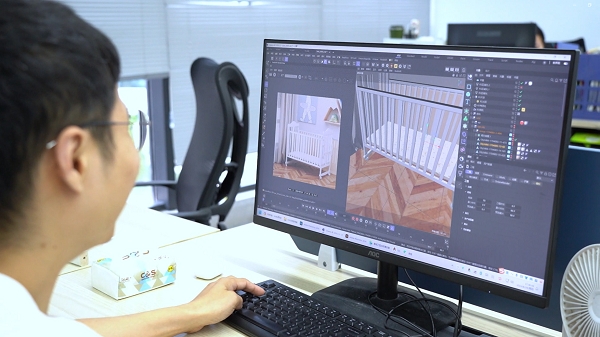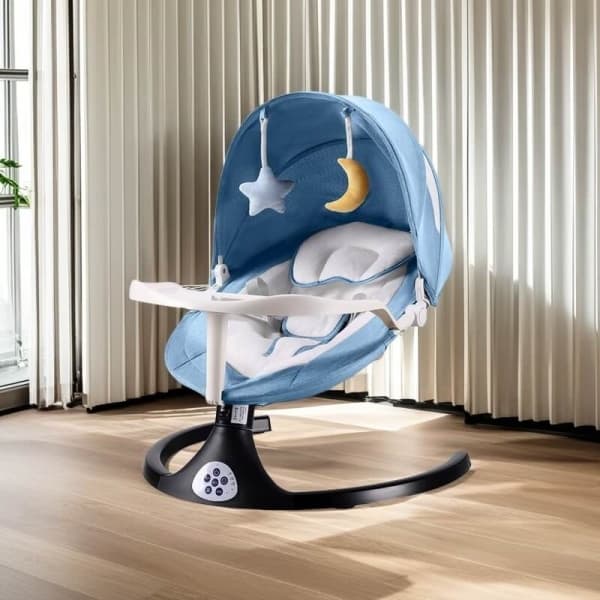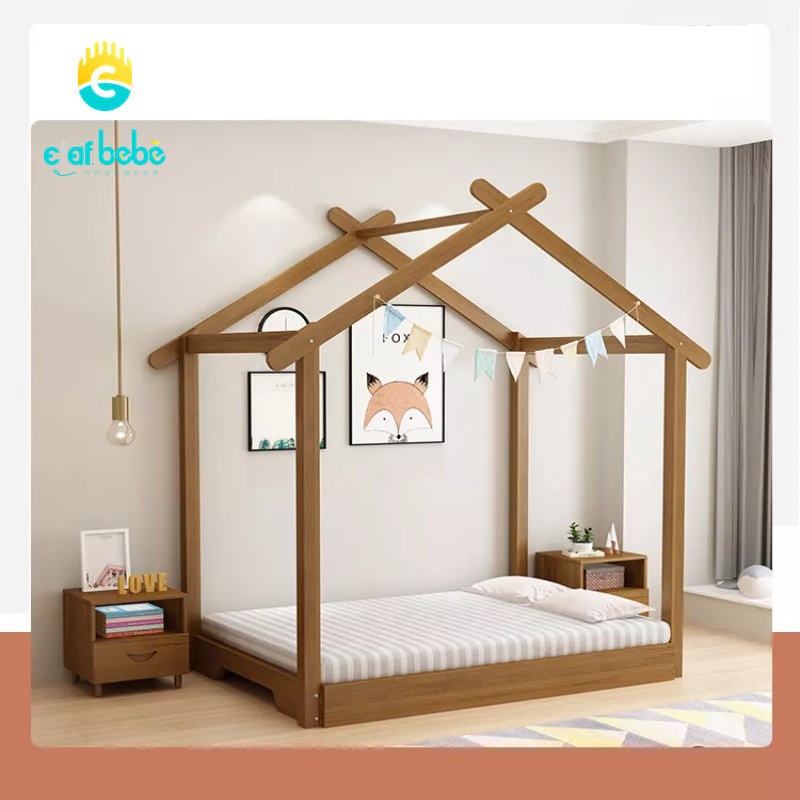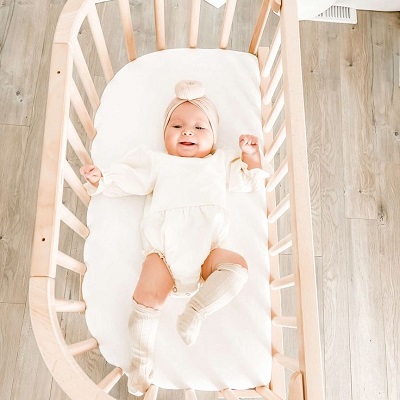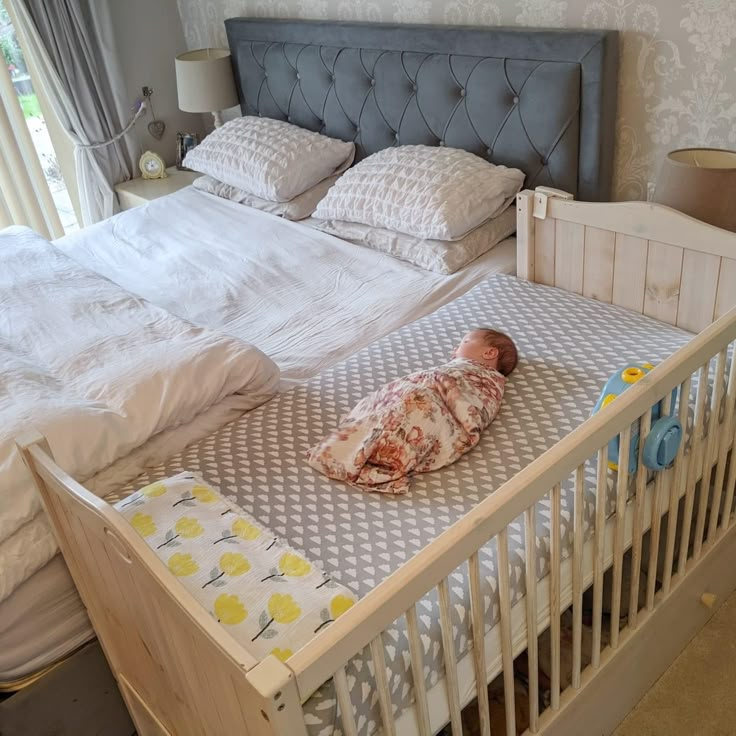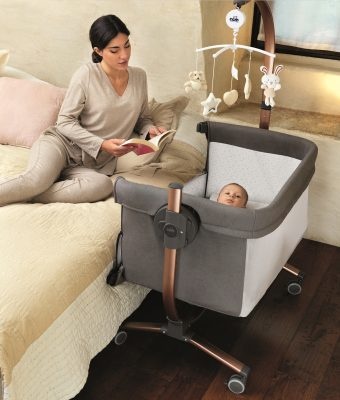Picture this: You’re whisking pancake batter while your toddler insists on “HELPING!!” Cue the chaos—flour tornadoes, a teetering step stool, and that heart-leaps-into-your-throat moment as they nearly faceplant off a chair. Enter the toddler kitchen helper—a parenting hack that turns kitchen meltdowns into “look-what-I-did!” pride.
More than just a step stool, this clever contraption lets little ones safely reach counter height, fostering independence while keeping them (and your sanity) intact.
But does it deserve the hype? Let’s take a closer look at this product that is increasingly appearing in modern parenting households.
What Exactly Is a Toddler Kitchen Helper?
A toddler kitchen helper is a kitchen aid designed for children to safely and autonomously participate in home cooking activities. It is usually an adjustable standing platform with guardrails to help toddlers reach the height of the kitchen counter while protecting them from falling or touching dangerous objects.
It’s a mini scaffolding system for tiny chefs. Think adjustable platform + wrap-around rails = safe access to counter height. No more death-grip on your leg while you chop veggies.
Unlike flimsy step stools, kitchen helpers:
✅ Let kids safely join in cooking—stirring, pouring, “taste-testing”.
✅ Block access to knives/ hot pans with strategic rail placement.
✅ Turn chores into bonding time: “You rinse veggies, I’ll chop!”
Montessori educators adore these for good reason: They let kids dive into real-world tasks, building confidence and motor skills. Plus, cleanup becomes a game—“Who can wipe the counter fastest?”
Why Do Parents Use Toddler Kitchen Helpers?
Parents don’t invest in kitchen helpers just to avoid stubbed toes or spilled milk. These tools solve a trifecta of toddler challenges: safety, skill-building, and sanity-saving. Here’s why they’ve become a kitchen staple:
Safety Without Sacrificing Exploration
In traditional parenting, the kitchen is often listed as a forbidden area for children due to dangerous elements such as knives and open flames. Toddlers are wired to climb, but balancing on chairs or step stools often ends in slips. Kitchen helpers eliminate this risk with 360-degree guardrails and non-slip platforms.
Kitchen helpers keep children’s standing area at a safe distance from dangerous sources (stoves, knife areas), and parents can designate exclusive operation areas. The elevated platform allows children and parents to maintain eye level, allowing parents to keep track of their children’s dynamics at any time.
This design not only satisfies the desire for exploration, but also avoids the deprivation of ability caused by overprotection.
Building Life Skills (and Tiny Confidence)
The kitchen is a natural interdisciplinary classroom, where children gain experience far beyond ordinary early childhood education courses. Montessori education emphasizes “work is learning”, and the efficiency of letting children participate in real housework is 3.2 times that of simulated games.
Kitchen helpers turn meal prep into Montessori-inspired learning.
Stirring pancake batter hones fine motor skills; washing veggies teaches cause and effect (“Dirt goes down the drain!”). Psychologists note that toddlers who regularly participate in household tasks develop stronger problem-solving abilities and earlier self-efficacy.
Parental Sanity, Preserved
Instead of juggling a clingy toddler while handling sharp knives, parents can say, “Want to help me peel bananas?” The helper becomes a designated “job site,” reducing whining and fostering teamwork.
With the help of a kitchen helper, parents can focus on cooking and spend less energy on taking care of active toddlers.
What Age Is a Toddler Kitchen Helper For?
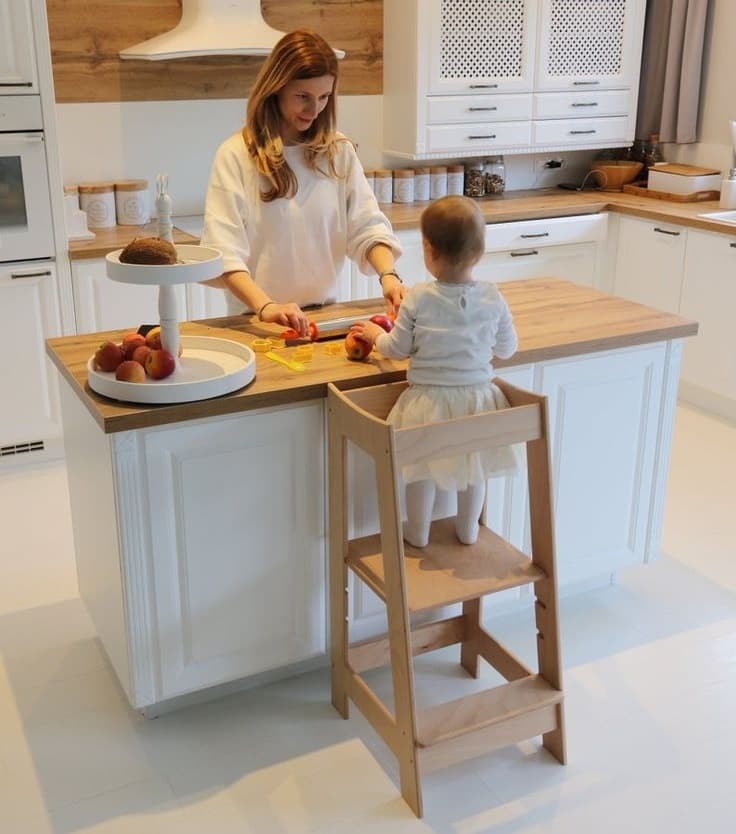
Most kitchen helpers are designed for 18 months to 5 years, but it is also closely related to children’s physical development, cognitive level, and hands-on ability.
18-24 Months
When children are 18-24 months old, they can stand steadily, climb stairs with help, and understand simple instructions (“Stand on the platform!”). However, turning around is easy to lose balance, and hand grasping is mainly based on the whole palm, and fine movements need to be developed.
Single use should be limited to ≤20 minutes, and sensory experiences such as observation and touch should be the main focus. It is recommended to participate in activities such as washing fruits and vegetables, tearing vegetable leaves, and pressing dough.
2.5-4 Years Old
During this stage, children are developing their balance ability. They can lean forward and reach counter tools without falling, and can stand on one foot and maintain balance for more than 3 seconds.
At this time, the front chest guard of the kitchen helper can be removed and replaced with a removable side baffle. And try to let children use tools such as plastic scrapers, silicone brushes, and egg beaters. It is recommended to participate in activities such as mixing batter, rolling out pie crust, and using safety scissors to handle herbs.
4-6 Years Old
At this stage, children can coordinate their hands (such as holding a bowl with one hand and stirring with the other hand). They can focus on a task for more than 5 minutes, understand the sequence, and execute three-step instructions.
You can add measuring tools (measuring cups, kitchen scales) for children. It is recommended to read illustrated recipes, prepare salad dressings, and perform other activities.
Choose an adjustable kitchen helper model, which usually offers 3-4 height settings. For smaller toddlers, start with the highest platform to minimize climbing effort. Lower it as they grow to maintain an ergonomic posture.
Design Features to Look for in a Quality Kitchen Helper
The design of kitchen helpers for young children needs to achieve a balance in three dimensions: safety, age-appropriateness, and sustainability. It must not only resist unexpected risks, but also stimulate children’s enthusiasm for participation, while adapting to the rapid physical changes of development.
Safety Rails That Actually Work
Look for wraparound guardrails that stand at least 12 inches high—tall enough to contain even the most determined climber. Avoid models with horizontal bars, which toddlers can use as footholds to escape. Pro Tip: Test the rail spacing (ideally less than 3.5 inches) to prevent head entrapment.
Adjustable Height Settings
A quality helper grows with your child. Seek models with at least two height adjustments (e.g., 12”, 15”, 18”) to accommodate everything from toddler pancake flipping to preschooler cookie decorating.
Non-Slip Everything
Textured steps and rubberized feet are non-negotiable. A 2022 Child Safety Review study found that 78% of kitchen falls occurred on smooth, untextured surfaces. For bonus points, choose a helper with a grip-tape step for rainy-day socked feet.
Material Matters
Solid Wood: Durable and eco-friendly (e.g., birch, maple), but heavier. The wooden parts are made of FSC-certified birch, with formaldehyde emission ≤0.3mg/L (EN717-1 standard)
Plastic Composite: Lightweight and easy to clean, but less sturdy over time.
Plywood: Budget-friendly but prone to warping in humid kitchens.
Footprint & Weight
A base wider than 20 inches ensures stability, but measure your kitchen space first. For small apartments, foldable models save precious square footage. Make sure it adopts a trapezoidal or pyramidal structure and ensures that the center of gravity is more than 15cm below the platform surface.
Different Types and Styles of Kitchen Helpers
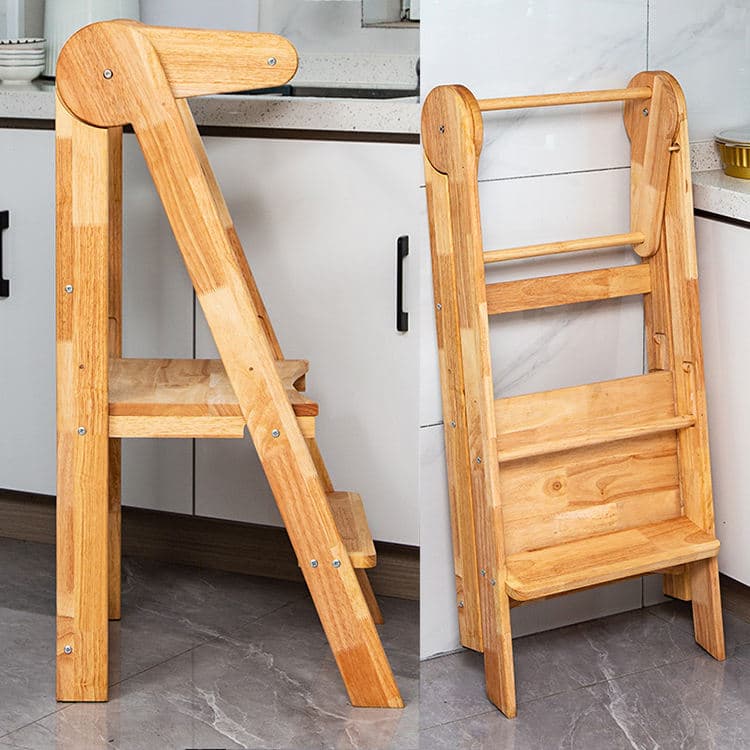
Classic Kitchen Helpers
Classic models focus on kitchen tasks, emphasizing simplicity, stability, and safety. Built with rigid frames and non-adjustable structures, they often include extra features like built-in shelves or tool hooks.
With no added features, they provide a sturdy platform for cooking activities, making them ideal for parents who want a dedicated, distraction-free workspace for their child.
Adjustable Height Kitchen Helpers
As children grow rapidly during the toddler years, height-adjustable kitchen helpers offer more longevity. These kitchen helpers include platforms that can be moved to different heights depending on the child’s size and skill level.
They allowing one product to grow with the child from around 18 months to 4 or 5 years old. In addition, it is especially useful in homes with multiple children of varying ages and heights.
Folding or Collapsible Kitchen Helpers
These models feature collapsible frames that can be stored flat against a wall or in narrow gaps, making them perfect for apartments or multi-use kitchens.
For example, a foldable design with locking hinges allows quick setup and breakdown, though it may sacrifice some stability compared to fixed models.
Convertible Kitchen Helpers
Convertible kitchen helpers offer versatility by transforming into other functional items, such as art easels, desks, or play tables. A popular convertible design might include removable panels that convert the platform into a chalkboard or a LEGO-compatible surface.
These are ideal for families that want a kitchen helper that fits into a play-based learning environment and supports multiple types of engagement.
Montessori-Inspired Designs
Rooted in Montessori education principles, these models tend to be more child-led in design. They often have sleek, natural wood finishes, minimal paint or plastic components, and a focus on open-ended use. Some may include chalkboard surfaces, handles for pushing, or extra compartments for holding utensils or books.
Rooted in Montessori principles, these helpers prioritize child independence and skill-building. They suit families committed to fostering self-reliance but may require more adult guidance initially.
Choosing the Right Style for Your Family
When selecting a kitchen helper, it’s important to think about both form and function. Ask yourself:
How much space do we have in the kitchen?
Will the helper need to be stored when not in use?
Do we want it to grow with the child?
Are we looking for a Montessori-style tool or something more colorful and playful?
How to Use a Kitchen Helper in Everyday Life?

A kitchen helper isn’t just for baking cookies—it’s a multitasking powerhouse that can simplify your routine and spark creativity. The following is an analysis of how to maximize the educational value of this tool based on daily application scenarios.
Morning Kitchen Tasks
Breakfast Prep: Let your toddler pour cereal into bowls (start with a small pitcher) or spread cream cheese on toast with a butter knife.
Coffee Sidekick: While you brew your latte, they can “practice” pouring water between cups or sorting measuring spoons.
Sink Play: Fill a basin with soapy water for washing plastic toys or “scrubbing” potatoes.
Afternoon Activities Beyond Cooking
Art Station: Clip paper to the rails for coloring, or use the platform as a playdough sculpting studio.
Science Experiments: Mix baking soda and vinegar for fizzy volcanoes, or layer liquids (oil, water, syrup) in jars.
Sensory Bins: Fill a tray with dried beans, spoons, and cups for pouring practice.
Evening Wind-Down
Dinner Duty: Assign age-appropriate tasks:
18–24 months: Tearing lettuce, rinsing veggies.
2–3 years: Stirring batter, sprinkling cheese.
4–5 years: Measuring ingredients, cracking eggs (with supervision).
DIY Kitchen Helpers: Are They Worth It?
Pinterest is flooded with plans for homemade kitchen helpers, promising savings and customization. But before you grab a saw, weigh the pros and cons.
At first glance, the appeal of making your own kitchen helper is obvious. Many families enjoy the sense of accomplishment that comes from building something for their child, and DIY projects can offer a level of customization that store-bought models sometimes lack.
You can adjust the height, add safety features like rails, or match the wood stain to your existing kitchen décor. For parents who are handy with tools and already have materials on hand, the cost savings can be significant compared to purchasing a high-quality commercial version.
However, unlike certified commercial products, DIY towers often lack standardized testing. A slight miscalculation in stability, the use of weak materials, or a missing guardrail can turn a helpful tool into a hazard.
Commercial kitchen towers are often designed with features like anti-tip bases, non-toxic finishes, and ergonomic grips—all designed with rigorous safety in mind.
Additionally, the time investment and required skill level should not be underestimated. While some people may find joy in woodworking, others may find it stressful or time-consuming, especially if they lack tools, a workshop, or prior experience.
That said, DIY kitchen helpers can still be a valuable option if approached thoughtfully. For families who enjoy crafting and have confidence in their ability to follow safe, child-focused design plans, making their own helper can be both cost-effective and deeply satisfying. It’s essential, however, to approach the project with the same rigor that a manufacturer would.
Conclusion
The toddler kitchen helper isn’t just another piece of furniture cluttering your home—it’s a bridge between your child’s curiosity and your need for sanity.
Whether your toddler is sprinkling cinnamon on oatmeal or “helping” knead dough, the kitchen helper transforms “I can’t” into “I did it!”—a small victory with lifelong ripple effects.

